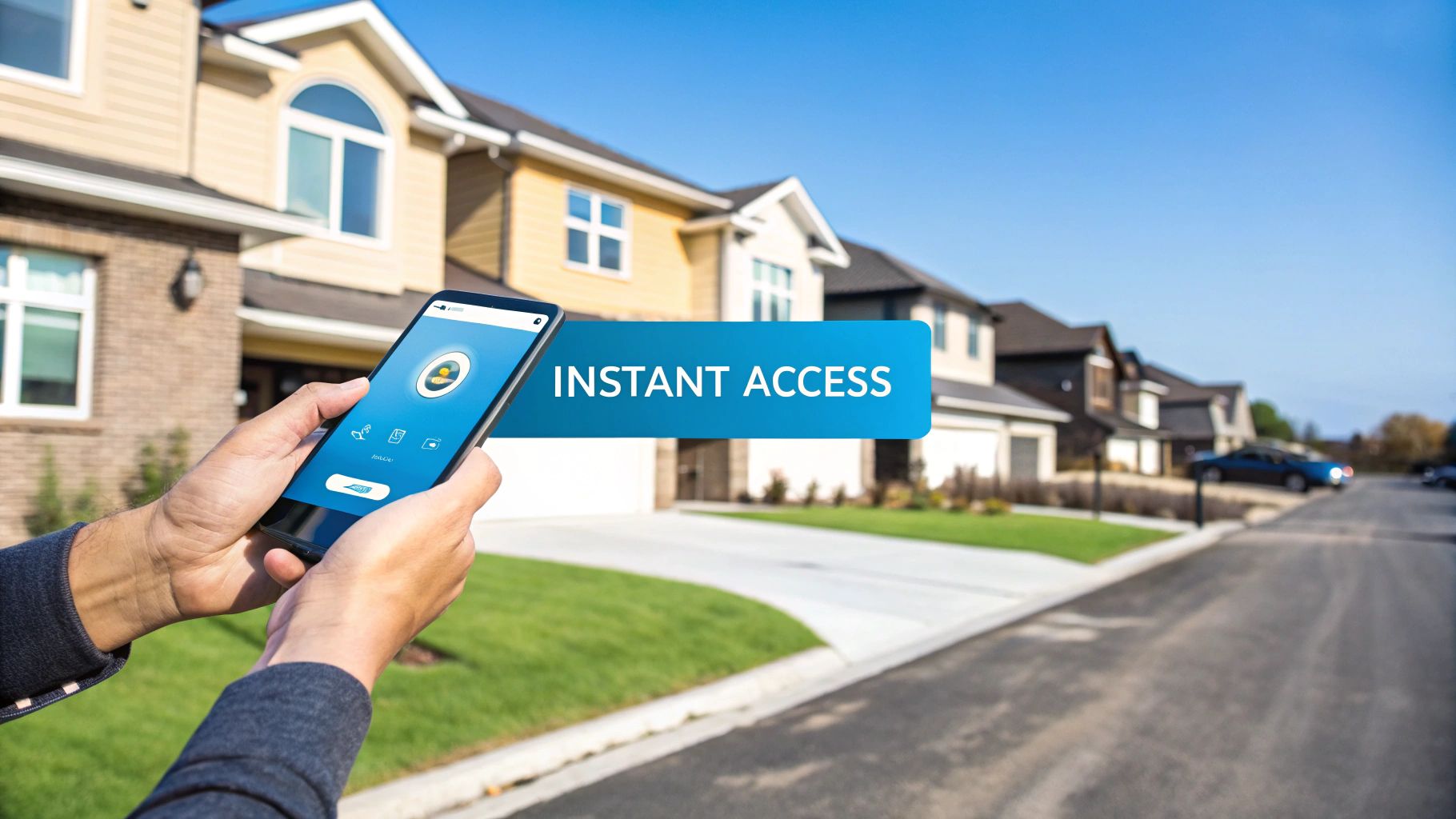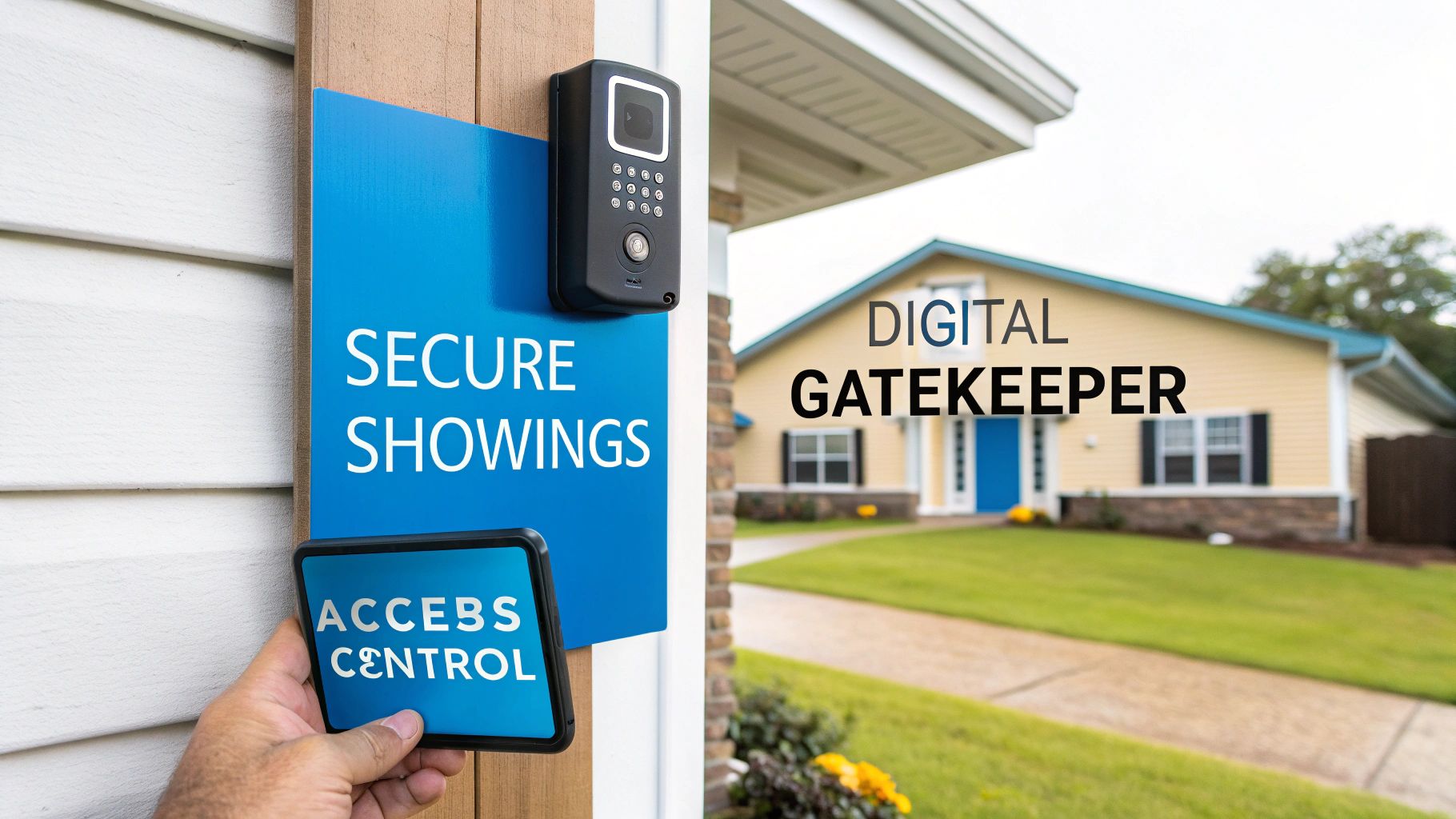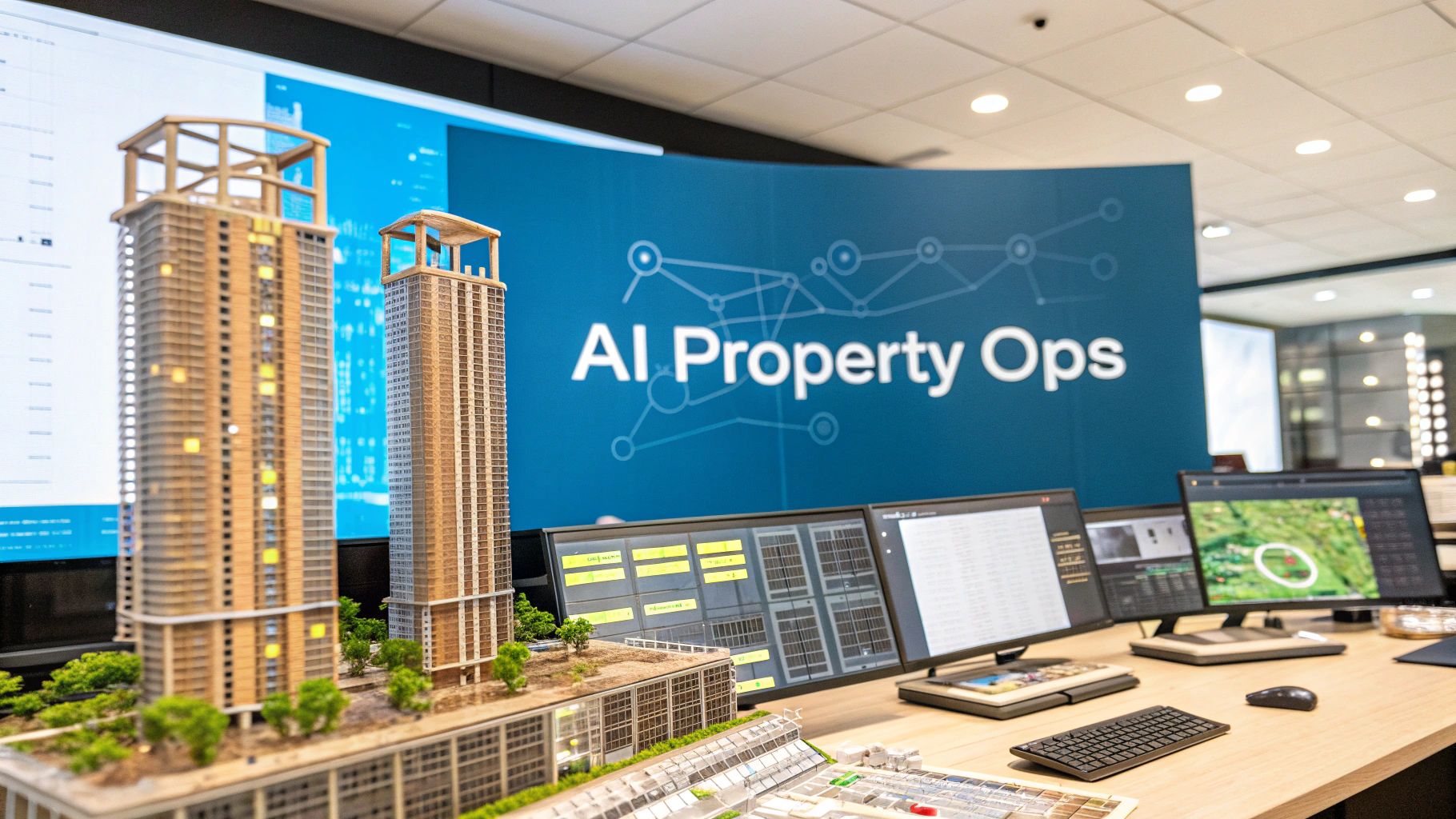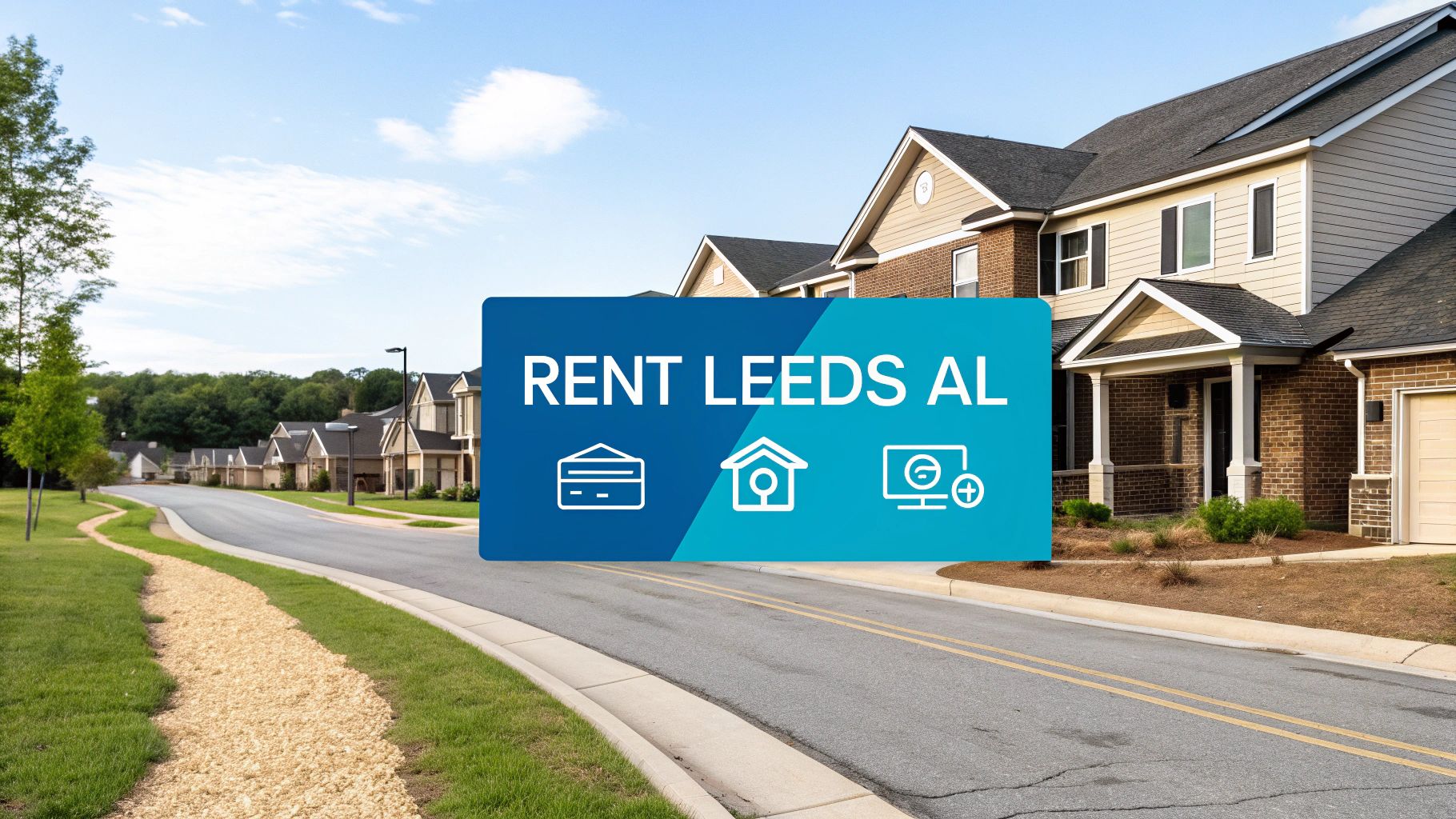When your analytics show a spike in searches for "self tour rental homes near me," it’s a direct signal from today's renters. They're telling you exactly what they want: instant, on-demand access to properties. For property management companies managing 1,000+ units, this isn't just a renter preference—it's a critical operational mandate that ties directly to your Days on Market (DOM), cost per door, and portfolio revenue.
Why Modern Renters Demand Self-Guided Tours

The modern renter operates in an on-demand economy. They expect immediate, autonomous service, and the traditional model of coordinating showing times is a major point of friction that kills lead-to-tour conversion rates. For tech-forward renters, waiting for a call back is archaic and inefficient.
This shift mirrors trends across the high-growth rental industry. For instance, the vacation rental market is projected to reach $134.26 billion by 2034, driven by consumers demanding flexible, self-service experiences. This same drive for control and convenience fuels the self-touring boom in the long-term rental space, and enterprise-level property managers must adapt their operations to capitalize on it.
The Impact on Enterprise Leasing KPIs
For property managers juggling hundreds or thousands of scattered-site properties, this change in renter behavior has a direct and measurable impact on core business metrics. Offering on-demand access isn't a perk; it's a powerful tool for optimizing your entire leasing funnel and achieving property management at scale.
A quick look at how implementing self-tour technology directly improves the KPIs that matter most to large portfolio managers.
Impact of Self-Tours on Key Property Management Metrics
Simply put, self-tours convert more high-intent leads into physical tours, faster. This translates directly to shorter vacancy periods and a more rapid speed-to-lease.
Adapting Operations for a New Era
Meeting this demand requires a fundamental operational shift. It’s about implementing a seamless, secure, and scalable system that gives renters autonomy while providing your team with the control and data needed for efficient remote property management operations.
For a portfolio of 1,000 units with an average rent of $2,000, reducing the average Days on Market (DOM) by just five days translates to over $32,000 in recovered revenue. This is the tangible financial impact of optimizing for speed-to-lease.
The key is to view self-touring not as a simple amenity, but as a core leasing strategy. It's a move that directly impacts cost per door optimization and paves the way for sustainable portfolio growth. To help decide if this approach is right for your specific portfolio, you can explore the detailed pros and cons of self-showings in our guide.
Building Your Scalable Self-Tour Tech Stack
If you’re serious about capturing "self tour rental homes near me" demand across a large portfolio, a few consumer-grade smart locks won’t work. To effectively manage hundreds—or thousands—of units remotely, you need a robust, integrated technology stack. This is the operational backbone for secure, efficient, and scalable multi-market property management.
At scale, your tech choices must be enterprise-grade and fully integrated. The goal is a zero-touch workflow from lead capture to post-tour feedback. This level of property management automation is what enables dramatic DOM reduction and improves lead-to-tour conversion rates across your entire portfolio.
Core Components of an Enterprise-Grade System
A truly effective self-tour tech stack has three critical layers that must work in perfect harmony.
- Enterprise-Grade Smart Lock Hardware: Invest in commercial-grade locks designed for high-traffic rental use. Key features include long battery life, remote management capabilities, and durability. Managing thousands of locks from a single dashboard is an operational necessity.
- A Centralized Showing Platform: This is the brains of the operation. A platform like Showdigs automates the entire process, from prospect identity verification to generating unique, one-time access codes and syncing tour feedback directly into your core systems.
- Seamless PMS Integration: Your touring platform must offer a robust API to connect with your Property Management Software (PMS). This critical integration ensures lead data, tour schedules, and prospect feedback flow automatically, eliminating data silos and manual entry.
This graphic breaks down the frictionless journey for renters, moving them from listing discovery to a completed tour.

This streamlined process is how enterprise property managers convert high-volume online search traffic into property visits, a key factor in minimizing vacancy loss.
Mini Case Study: Automation in Action
A property management company with over 2,500 single-family rentals across multiple states faced significant operational drag from manual showing coordination, which inflated their DOM and leasing costs.
Their solution was an end-to-end automated tech stack. They selected an enterprise-grade smart lock provider with an open API and integrated it with a centralized showing platform connected directly to their PMS, AppFolio.
The result: When a lead was captured from an ILS, it automatically synced. The prospect could instantly self-verify their identity and book a tour on demand. A unique access code was generated, and all post-tour activity was logged back into AppFolio without leasing agent intervention. This automation cut their average DOM by 12 days, driving significant revenue recovery and enabling scalable growth.
Winning Local Search for Your Rental Listings
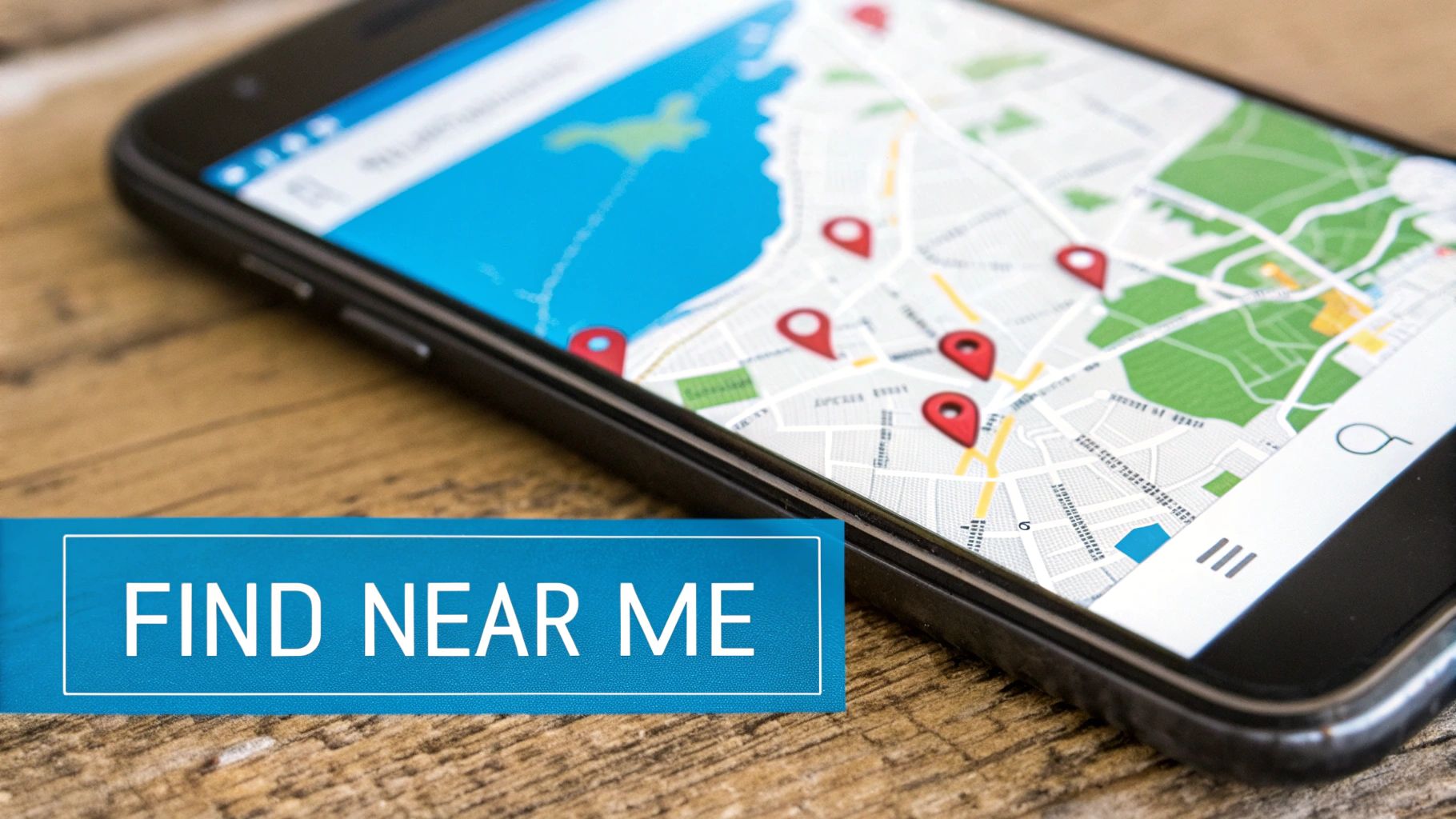
Having the right self-tour technology is a critical first step, but it’s ineffective if renters can't find your properties when they search "self tour rental homes near me." For property managers with large portfolios, mastering local search is a non-negotiable strategy for days on market reduction and revenue optimization.
This requires a hyperlocal SEO approach, optimizing each property listing to appear at the precise moment a qualified renter is searching in that neighborhood. It’s the digital equivalent of placing a "Tour Now" sign in front of every high-intent prospect.
Optimizing Individual Property Listings
Each rental in your portfolio is a unique asset in its own micro-market. To capture hyperlocal search traffic, every listing must be optimized.
Start with title tags and meta descriptions—your first impression in search results.
- Weak Title: 123 Main St. For Rent
- Strong Title: Self-Tour This 3-Bed Home in North Austin | 123 Main St
- Weak Description: A great rental property. Call for details.
- Strong Description: Tour this renovated North Austin home on your schedule. Instant access for self-guided tours available daily. This 3-bed, 2-bath rental won't last!
The strong examples directly address the searcher's intent and highlight the immediate benefit—the self-tour. This simple change can significantly improve click-through rates and improve lead to tour conversion rates.
Harnessing Google Business Profile and Schema
Your property management company's Google Business Profile (GBP) is a powerhouse for local visibility. While you cannot create a GBP for every rental, your main company profile serves as a digital anchor.
For operators managing multi-market portfolios, creating a well-optimized Google Business Profile for each regional office is a non-negotiable step. It anchors your presence in each specific market, building trust and authority with both search engines and prospective renters.
Next is the technical but crucial step: schema markup. This code helps Google understand your content. Use "RealEstateListing" and "RentAction" schema to explicitly tell Google, "This is a property for rent."
You can also embed self-tour availability details within the schema. This helps generate eye-catching rich snippets in search results, signaling to the user that you have exactly what they need before they even click, making your self tour rental homes near me offering unmistakable to both users and search engines.
Marketing On-Demand Tours to Slash Vacancy Rates
Once your listings are optimized for local search, aggressively promote the on-demand convenience of self-tours. This isn't a minor feature; it's a core marketing message built around immediacy. This strategy accelerates your leasing cycle and captures high-intent leads before competitors can respond.
For any manager of a large portfolio, this proactive approach is essential for reducing vacancy rates and maximizing revenue.
The goal is to make self-touring the most obvious and appealing option. This means crafting powerful calls-to-action (CTAs) that create urgency and highlight your unique value proposition: instant access.
Crafting High-Conversion Calls-to-Action
Your CTAs should be prominent on your website, social media ads, and Internet Listing Service (ILS) profiles. Replace passive language like "Contact Us for a Tour" with direct, benefit-driven commands.
- "Tour This Home Now": Direct, implies immediacy, and perfectly matches the "self tour rental home near me" search intent.
- "Explore On Your Schedule": Speaks to the renter’s desire for flexibility and control.
- "Unlock Instant Access": A modern, tech-forward CTA that frames your properties as convenient and premium.
Integrate these CTAs into your lead nurturing emails and automated SMS responses. The first automated message a lead receives should immediately offer a self-guided tour link, capitalizing on peak interest.
By positioning self-service touring as the modern, premium choice, you're not just offering convenience; you're creating a competitive advantage. This strategy directly addresses the primary pain point of scheduling friction, which is a major cause of lead drop-off in traditional leasing models.
This marketing approach taps into consumer habits that fueled growth in other rental sectors. The global vacation rental market is projected to hit USD 136.83 billion by 2033, driven by on-demand digital booking. You can explore the full vacation rental market report. Applying these principles to long-term rentals is a proven strategy for speed to lease optimization.
When you market the on-demand nature of your tours, you transform your portfolio from a static list of properties into a network of homes available for immediate viewing. This shift is a game-changer for scaling property management operations. For more ideas, check out our guide on how to lease your properties quicker in 2024.
Calculating the ROI of Your Self-Tour Program
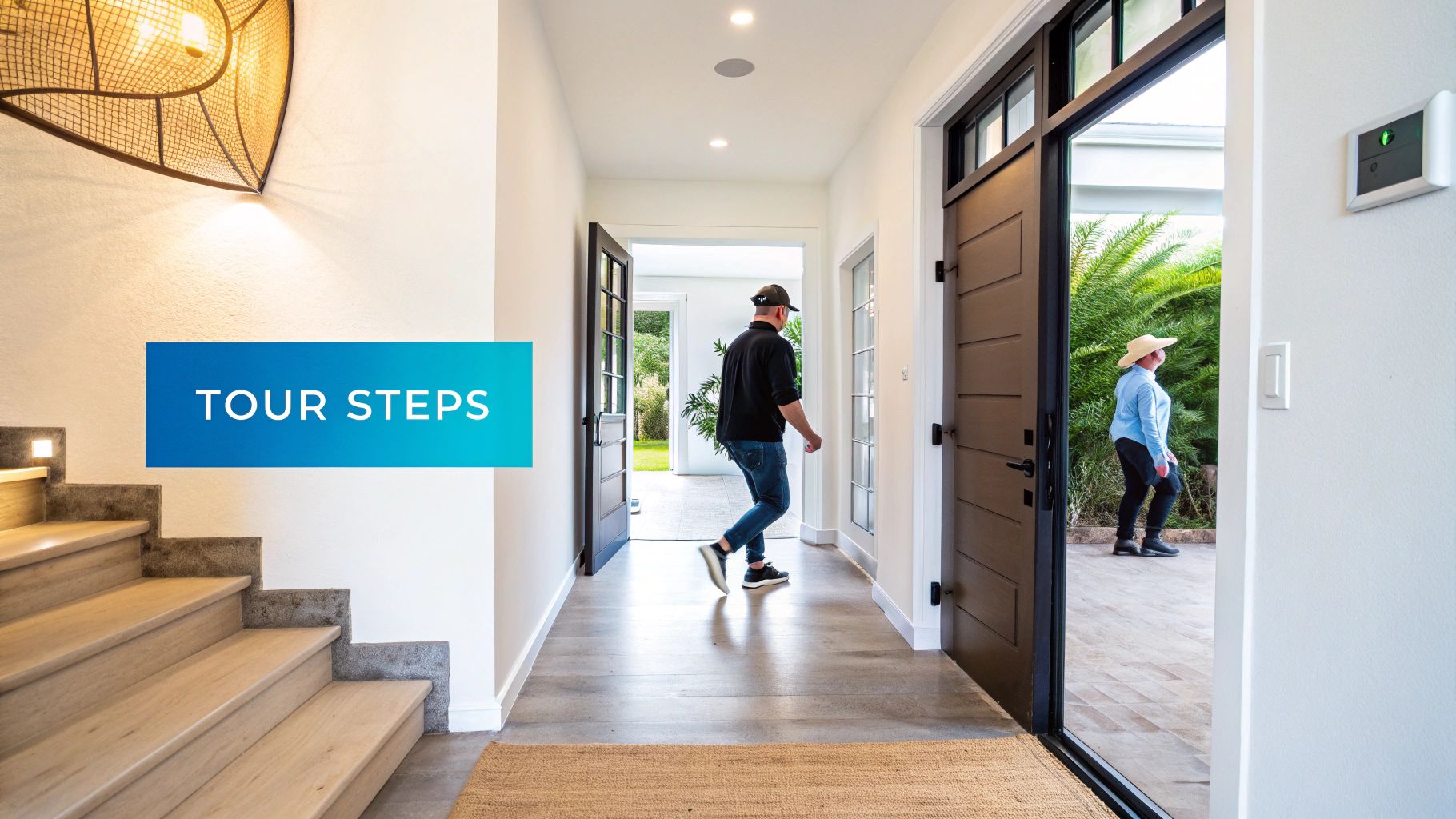
For any large-scale property management company, new initiatives live and die by their financial performance. Rolling out a self-tour program to capture "self tour rental homes near me" traffic must be justified on the balance sheet.
The return on investment (ROI) for a self-tour program is straightforward to measure and highly impactful. The analysis provides the hard data needed to validate the strategy across your entire portfolio. The calculation centers on recovering revenue previously lost to vacancy.
Key Metrics for ROI Analysis
To build a solid business case, focus on these critical key performance indicators (KPIs) that link your on-demand tour strategy to financial outcomes.
- Lead-to-Tour Conversion Rate: A top-of-funnel efficiency metric measuring the percentage of inquiries that result in a physical tour. A high rate indicates your automated system is effectively converting interest into action.
- Cost-Per-Lease (CPL): Calculate total marketing and leasing costs (software, hardware, ad spend) divided by signed leases. Self-tours reduce this by minimizing agent labor and converting leads faster, thereby lowering ad spend over time.
- Days on Market (DOM): The ultimate metric. Every day shaved off your average DOM is another day of rent collected, directly impacting your portfolio's gross potential rent.
Large-scale property managers are obsessed with Days on Market reduction for good reason. A vacant property is a daily financial drain. Calculating the exact revenue recovered from even a small DOM reduction provides the most powerful argument for self-tour technology.
The Revenue Recovery Formula
Quantifying the direct financial benefit is simple. It comes down to calculating the revenue gained from filling properties faster across your portfolio, providing a clear, defensible number for stakeholders.
Let's walk through a real-world example for a 1,000-unit portfolio.
DOM Reduction Revenue Impact Calculator
This calculator quantifies the direct financial benefit of self-tours by showing the revenue recovered from reduced vacancy days across your portfolio.
The formula behind this is: (Average Rent / 30 Days) x DOM Reduction x (Total Units x Annual Turnover Rate)
Assuming a standard 45% annual turnover rate, the math reveals a staggering $144,900 in recovered revenue. This is real money added back to your bottom line, demonstrating a clear ROI on your technology investment.
Once you have this data, you can A/B test CTAs, follow-up cadences, and marketing messages to further optimize performance. When thinking about ROI, it also pays to explore different lead-gen models. For example, understanding strategies for maximizing your marketing ROI and conversion rates can open your eyes to more efficient ways to get qualified prospects in the door.
Of course, none of this is possible without the right technology. For a deep dive, check out our guide on how to choose the right self-showing software to meet your portfolio's specific needs.
Answering Your Top Questions About Self-Guided Tours
Implementing any new process across a large portfolio raises tough but fair questions. Adopting technology to capture "self tour rental homes near me" traffic is a significant operational shift, and you need to understand the implications before committing.
Here are the direct answers to the questions we hear most from enterprise property managers considering self-guided tours. This is about sharpening your remote property management operations and boosting your bottom line.
How Do You Keep the Property Secure During a Self-Tour?
This is always the top concern. Enterprise-level self-tour systems utilize a multi-layered security protocol that is often more secure than traditional methods.
The system is built on several checkpoints:
- Real Identity Verification: Prospects must verify their identity before booking a tour, immediately filtering out non-serious inquiries.
- One-Time, Time-Locked Codes: Renters receive a unique access code that works only for their specific tour window, eliminating the risk of copied keys.
- Smart Lock Hardware: Every entry and exit is logged and time-stamped, creating a complete digital audit trail for total oversight.
Furthermore, platforms like Showdigs incorporate advanced, AI-driven fraud detection to ensure only legitimate, high-intent renters gain access—a level of control far beyond handing keys to a lightly vetted prospect.
What’s the Real Impact on Days on Market?
The primary driver for adoption is the dramatic reduction in Days on Market (DOM). While results vary by market, it’s not uncommon for large portfolios to slash their DOM by 45-50%.
This is due to speed-to-lease optimization. By offering on-demand, same-day tours, you engage motivated renters at their moment of peak interest. This eliminates the scheduling friction that causes lead drop-off, significantly compressing the timeline from initial click to signed lease.
How Does This System Actually Talk to Our PMS?
For any enterprise property management system, seamless integration is non-negotiable. Leading self-tour platforms are built with robust APIs to connect directly into major Property Management Software (PMS) like AppFolio, Yardi, or RentManager.
This API connection automates the entire leasing workflow. A new lead from an ILS syncs to your PMS, is pushed to the touring platform, and all tour activity and feedback are logged back into the prospect's profile in your PMS. This eliminates manual data entry, prevents lead leakage, and allows your team to operate at peak efficiency.
Ready to see how Showdigs can slash your Days on Market and automate your leasing funnel? Our AI-backed platform is purpose-built for property managers with large, distributed portfolios who demand a scalable, secure, and fully integrated solution. Schedule a demo today to calculate your potential ROI and see our portfolio management technology in action.




